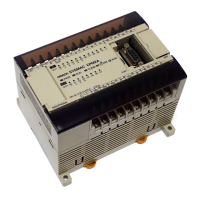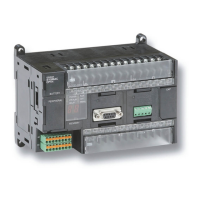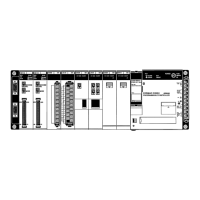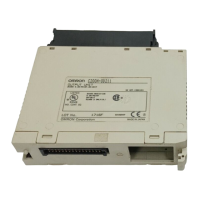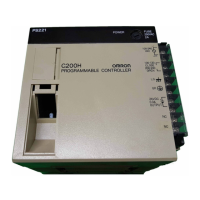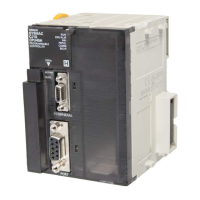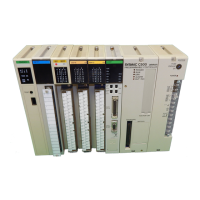59
4-3 Programming Console Operations
4-3-1 Overview
The following table lists the programming and monitoring operations that can be
performed from a Programming Console. Refer to the rest of this section for
details on operational procedures.
Name Function
Clearing memory Clears all or part of the Program Memory and any data areas that are not read-only, as well
as the contents of the Programming Console’s memory.
Reading/clearing error
messages
Displays and clears error messages and displays MESSAGE instruction messages.
Buzzer operation Turns on and off the buzzer that sounds when Programming Console keys are pressed.
Setting a program
memory address
Sets the specified program memory address when reading, writing, inserting and deleting
programs.
Reading a program
memory address
Reads the contents of the Program Memory. Displays the status of the currently displayed bit
in PROGRAM and MONITOR modes.
Instruction search Finds occurrences of the specified instruction in the program.
Bit operand search Finds occurrences of the specified operand bit in the program.
Inserting and deleting
instructions
Inserts or deletes instructions from the program.
Entering or editing
programs
Overwrites the contents of the current Program Memory to either input a program for the first
time or to change a program that already exists.
Checking the program Checks for programming errors and displays the program address and error when errors are
found.
Bit, digit, word monitor Monitors the status of up to 16 bits and words, although only 3 can be shown on the display
at one time.
Multiple address
monitor
Monitors the status of up to 6 bits and words simultaneously.
Differentiation monitor Monitors the up or down differentiation status of a particular bit.
Binary monitor Monitors the ON/OFF status of any word’s 16 bits.
3-word monitor Monitors the status of three consecutive words.
Signed decimal
monitor
Converts the contents of the specified word from signed hexadecimal (two’s complement
format) to signed decimal for display.
Unsigned decimal
monitor
Converts hexadecimal data in a word to unsigned decimal for display.
3-word data
modification
Changes the contents of one or more of the 3 consecutive words displayed in the 3-Word
Monitor operation.
Changing timer,
counter SV 1
Changes the SV of a timer or counter.
Changing timer,
counter SV 2
Makes fine adjustment changes to the SV of the timer or counter.
Hexadecimal, BCD
data modification
Changes the BCD or hexadecimal value of a word being monitored.
Binary data
modification
Changes the status of a word’s bits when the word is being monitored.
Signed decimal data
modification
Changes the decimal value of a word being monitored as signed decimal data, within a
range of –32,768 to 32,767. The contents of the specified word are converted automatically
to signed hexadecimal (two’s complement format.)
Unsigned decimal data
modification
Changes the decimal value of a word being monitored as unsigned decimal data, within a
range of 0 to 65,535. A change into hexadecimal data is made automatically.
Force set/reset Forces bits ON (force set) or OFF (force reset.)
Clear force set/reset Restores the status of all bits which have been force set of reset.
Hex-ASCII display
change
Converts word data displays back and forth between 4-digit hexadecimal data and ASCII.
Displaying the cycle
time
Displays the current average cycle time (scan time.)
Programming Console Operations
Section 4-3
